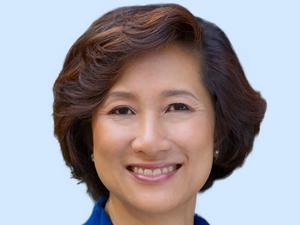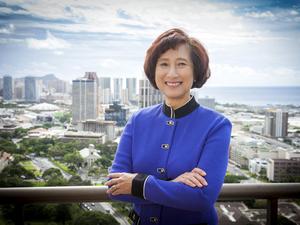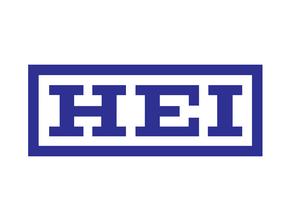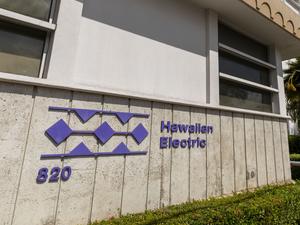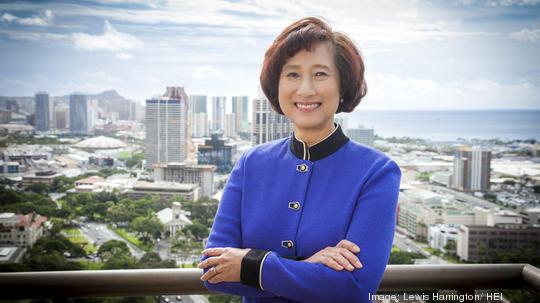
Back in the mid-1980s, Connie Lau wasn’t sure what the long-term future would entail upon her return home to Hawaii from the Mainland. She had worked at a large San Francisco law firm and was preparing to join Hawaiian Electric Co. as assistant corporate counsel in 1984 in her early 30s.
“I had two first cousins who were working at Hawaiian Electric, one who had 30 years of service and the other who had 33 years of service,” she recalled. “And I thought to myself, ‘Oh my gosh, that's a long time, and there is no way that I would ever work for the company that long.’
“And here I am 37 years later.”
Lau, 69, the Hawaiian Electric Industries president and CEO since 2006, is retiring at the end of the year as part of a wholesale leadership changeover at HEI and its subsidiaries that was announced Oct. 5. HECO president and CEO Scott Seu has been tapped as Lau’s successor for the top job by the HEI Board of Directors. In turn, Shelee Kimura, HECO’s senior vice president of customer service and public affairs, was picked to follow in Seu’s footsteps. And earlier this year, Ann Teranishi succeeded Rich Wacker as American Savings Bank CEO.
Over the decades, Lau shaped the direction of HEI’s two main subsidiaries — the HECO utility and American Savings Bank, the latter of which she was president and CEO from 2001 to 2008.
Lau helped ASB rise from a community bank to the state’s third-largest banking institution. In 2008, she signed the Hawaii Clean Energy Initiative with then-Gov. Linda Lingle to help set the state on a path to attempt to achieve 100% renewable power. More recently, she helped establish HEI’s environmental, social and governance, or ESG, goals.
Lau plans to spend more time with family, especially her grandchildren, but will likely find ways to remain busy. Since 2012 she has chaired the National Infrastructure Advisory Council to advise U.S. presidents. She is also chair of the board of directors for Punahou and the Consuelo Foundation, and serves on the boards of Matson, Associated Electrical & Gas Insurance Services, and the Asia Pacific Center for Security Studies.
Is there anything left you want to accomplish before the baton officially passes at the end of the year?
Not particularly. … They never say that time is perfect, but is actually a really good time for the HEI companies in that, the performance-based rate-making framework for the utility just went into place on June 1. The bank is in a good spot and Pacific Current is working on some really exciting, sustainable infrastructure projects.
So a lot of it is really about implementing and executing on our current plans. And that's really the job of the team that is now in place and actually will officially take over Jan. 1.
What do you think the combined leadership change at HEI and its subsidiaries represents for the state?
I think we figured out that between all the operating companies, we probably touch just about everybody in the state and you know, that's part of the vision of the board and the mission of the company to be the catalyst for a better Hawaii. So what is common among … this new team is that they are very involved in and engaged in Hawaii and the goals that our policymakers have for the state.
Clearly, the utility has been a key player in the transformation to clean energy and renewable energy, [and] the electrification of the economy. And the bank has been very involved in the innovation space and helping finance new businesses and [trying to help] with some of the really knotty problems that our community faces, like affordable housing.
So, I think that if we can really master that … that could make a huge impact for Hawaii going forward.
What is your most treasured memory from your time with the companies?
My favorite job still today was the transformation of American Savings Bank, from a simple thrift to a full-service community bank. And what I loved about it was that it was a wholesale transformation of the company in that we set a whole new strategic plan.
I got involved in selecting the kalo logo that American still uses today. ... I looked at dozens of designs from several designers and nothing really clicked. And partly it was because if you think about the name of the bank, American Savings Bank, you think red, white and blue, stars and stripes.
And I and was trying to transform it into a community bank that would be there for the community. Red, white and blue, and stars and stripes didn't necessarily represent our local communities. I was walking around our offices one day, and … [saw] some artwork by a local artist that was a repeating pattern of the kalo leaf. I was like, ‘wow, that's it.’
If you think about a leaf in the early morning with the dew drop on it, the kalo leaf, the veins are like a star. And there was few drops right in the center, just sparkling. And of course, as you know, the kalo was very associated with Hawaii and our local culture. And, to go further, it was the sustenance for the Hawaiian people. And that's what you wanted the bank to be, something that was really there for the community.
What we are really trying to do was create a viable third option for businesses to the two big banks, Bank of Hawaii and First Hawaiian Bank. And I think today they proved that they are a great option for businesses as well as individuals.
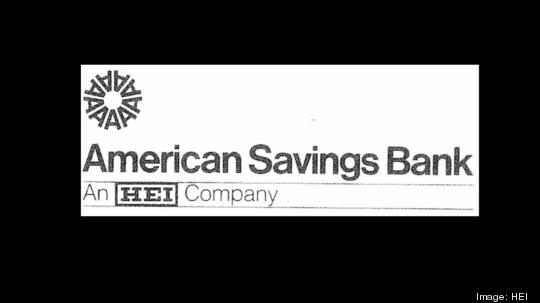
Do you have any regrets or unfulfilled goals?
What I wish I had been able to do was to be as involved with Hawaiian Electric [as ASB] — and of course Scott is different because Scott is coming from having been CEO of Hawaiian Electric, so he's very steeped in all the things Hawaiian Electric is doing.
But I never really had that opportunity as CEO because I was … the board chair for a long time and head of the holding company.
And so, I had to be a little bit more removed from all of the things that were going on at Hawaiian Electric, which were just wonderful things as well. But I always wish I could have been more involved there.
What challenges do you think your successors will face?
I don't know that it's a point that the issues are going to be much different.
In fact, that's what some people really always complain about, is that we know what the issues are — it’s how do we fix it? And I think that remains the challenge not only for HEI, but for our entire community.
But I'm really excited about the principles of ESG, which recognize that you can't do it alone. All of these initiatives, whether it's decarbonization or affordability or sustainability, are all “kakou” things. And it takes the whole community holding hands to be able to move forward.
Take renewable energy, right? You can have a policy that wants renewable energy, but that result in the construction of large wind farms and solar farms, which may … clash with land-use policies around affordable housing. And those issues have to be reconciled on a on a community-wide basis, statewide basis.
And so I think that's the challenge, as Scott, Shelee, [and] Ann run the HEI businesses to be able to work together with other entities in the state to actually solve some of these issues, longstanding issues, that Hawaii has always faced.
Do you think you’ll be remembered as a trailblazer for women / minorities?
I think I've been a trailblazer, whether I wanted to be remembered that way or not. And yes … I was the first in most of those [positions].
It's interesting how things change. You know, when I started at Hawaiian Electric, there were no women in positions higher than managers and there was only one Asian executive. So, things have changed a lot and I'm really glad for it.
Now I think our company, in the managerial and executive ranks, very much represents the communities that we serve. And that's a really good thing.
